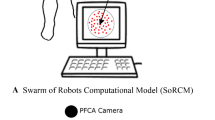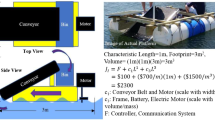Abstract
Microscopic robots in the body could harvest energy from ultrasound to provide on-board control of autonomous behaviors such as measuring and communicating diagnostic information and precisely delivering drugs. This paper evaluates the acoustic power available to micron-size robots that collect energy using pistons. Acoustic attenuation and viscous drag on the pistons are the major limitations on the available power. Frequencies around 100kHz can deliver hundreds of picowatts to a robot in low-attenuation tissue within about 10cm of transducers on the skin, but much less in high-attenuation tissue such as a lung. However, applications of microscopic robots could involve such large numbers that the robots significantly increase attenuation, thereby reducing power for robots deep in the body. This paper describes how robots can collectively manage where and when they harvest energy to mitigate this attenuation so that a swarm of a few hundred billion robots can provide tens of picowatts to each robot, on average.








Similar content being viewed by others
Data availability
Data sharing is not applicable to this article as no datasets were generated or analyzed for this study.
References
Dong L, Nelson BJ (2007) Robotics in the small. part II: Nanorobotics. IEEE Robot Autom Mag 14:111–121
Nelson BJ, Kaliakatsos IK, Abbott JJ (2010) Microrobots for minimally invasive medicine. Annu Rev Biomed Eng 12:55–85
Sahoo SK, Parveen S, Panda JJ (2007) The present and future of nanotechnology in human health care. Nanomed Nanotechnol Biol Med 3:20–31
Schulz Mark J, Shanov Vesselin N, Yun Yeoheung (eds) (2009) Nanomedicine Design of Particles, Sensors, Motors, Implants, Robots, and Devices. Engineering in Medicine and Biology. Artech House, Boston
Amar AB, Kouki AB, Cao H (2015) Power approaches for implantable medical devices. Sensors 15:28889–28914
Bazaka Kateryna, Jacob Mohan V (2013) Implantable devices: Issues and challenges. Electronics 2:1–34
Cook-Chennault KA, Thambi N, Sastry AM (2008) Powering MEMS portable devices - a review of non-regenerative and regenerative power supply systems with special emphasis on piezoelectric energy harvesting systems. Smart Mater Struct 17:043001
Freitas Jr. RA (1999) Nanomedicine, volume I: Basic Capabilities. Landes Bioscience, Georgetown, TX. Available at www.nanomedicine.com/NMI.htm
Martel Sylvain (2007) The coming invasion of the medical nanorobots. Nanotechnology Perceptions 3:165–173
Somasundar Ambika, Sen Ayusman (2021) Chemically propelled nano and micromotors in the body: Quo vadis? Small 17:2007102
Konofagou EE (2017) Trespassing the barrier of the brain with ultrasound. Acoust Today 13(4):21–26
Pascal Aurea et al (2020) Histologic evaluation of activation of acute inflammatory response in a mouse model following ultrasound-mediated blood-brain barrier using different acoustic pressures and microbubble doses. Nanotheranostics 4:210–223
Ghanem MA et al (2020) Noninvasive acoustic manipulation of objects in a living body. Proc Natl Acad Sci 117:16848–16855
Mohanty S, Khalil IS, Misra S (2020) Contactless acoustic micro/nano manipulation: a paradigm for next generation applications in life sciences. Proceedings of the Royal Society A: Mathematical, Physical and Engineering Sciences 476:20200621
Rao KJ, Li F, Meng L, Zheng H, Cai F, Wang W (2015) A force to be reckoned with: A review of synthetic microswimmers powered by ultrasound. Small 11:2836–2846
Shaglwf Z, Hammarstrom B, Shona Laila D, Hill M, Glynne-Jones P (2019) Acoustofluidic particle steering. J Acoust Soc Am 145:945–955
Esteban-Fernandez de Avila B, et al (2018) Hybrid biomembrane-functionalized nanorobots for concurrent removal of pathogenic bacteria and toxins. Sci Robot 3:eaat0485
Aghakhani A, Yasa O, Wrede P, Sitti M (2020) Acoustically powered surface-slipping mobile microrobots. Proc Natl Acad Sci 117:3469–3477
Ren L, et al (2019) 3D steerable, acoustically powered microswimmers for single-particle manipulation. Sci Adv 5:eaax3084
Luo Tao, Mingming Wu (2021) Biologically inspired micro-robotic swimmers remotely controlled by ultrasound waves. Lab Chip 21:4095–4103
Brooks Allan M, Strano Michael S (2020) A conceptual advance that gives microrobots legs. Nature 584:530–531
Webb Barbara (2020) Robots with insect brains. Science 368:244–245
Wiesel-Kapah I, et al (2016) Rule-based programming of molecular robot swarms for biomedical applications. In Brewka G editor. Proc of the 25th Intl Joint Conf on Artificial Intelligence (IJCAI16), pages 3505–3512
Norman Sumner L et al (2021) Single-trial decoding of movement intentions using functional ultrasound neuroimaging. Neuron 109:1554-1566.e4
Feher J (2017) Quantitative Human Physiology. Academic Press, 2nd edition
Douglas Shawn M, Bachelet Ido, Church George M (2012) A logic-gated nanorobot for targeted transport of molecular payloads. Science 335:831–834
Hogg Tad (2007) Coordinating microscopic robots in viscous fluids. Auton Agent Multi-Agent Syst 14(3):271–305
Li J, Esteban-Fernandez de Avila B, Gao W, Zhang LF, Wang J (2017) Micro/nanorobots for biomedicine: Delivery, surgery, sensing, and detoxification. Sci Robot 2:eaam6431
Morris K (2001) Macrodoctor, come meet the nanodoctors. The Lancet 357:778
Jager EW, Inganas O, Lundstrom I (2000) Microrobots for micrometer-size objects in aqueous media: Potential tools for single-cell manipulation. Science 288:2335–2338
Floreano D, Lipson H (2021) From individual robots to robot societies. Sci Robot 6(eabk2787):2021
Tamas V et al (1995) Novel type of phase transition in a system of self-driven particles. Phys Rev Lett 75:1226–1229
Xie H, et al (2019) Reconfigurable magnetic microrobot swarm: Multimode transformation, locomotion, and manipulation. Sci Robot 4:eaav8006
Schuerle S, et al (2019) Synthetic and living micropropellers for convection-enhanced nanoparticle transport. Sci Adv 5:eaav4803
Hernandez-Ortiz Juan P, Stoltz Christopher G, Graham Michael D (2005) Transport and collective dynamics in suspensions of confined swimming particles. Phys Rev Lett 95:204501
Rubenstein Michael, Cornejo Alejandro, Nagpal Radhika (2014) Programmable self-assembly in a thousand-robot swarm. Science 345:795–799
Bonabeau Eric, Dorigo Marco, Theraulaz Guy (1999) Swarm Intelligence: From Natural to Artificial Systems. Oxford University Press, Oxford
Wang Xudong et al (2007) Direct-current nanogenerator driven by ultrasonic waves. Science 316:102–105
Denisov Alexey, Yeatman Eric (2011) Stepwise microactuators powered by ultrasonic transfer. Proc Eng 25:685–688
Martel S, et al (2008) Flagellated bacterial nanorobots for medical interventions in the human body. In D. Meldrum and O. Khatib, editors. Proc of 2nd IEEE Conf on Biomedical Robotics and Biomechatronics pages 264–269
Hogg Tad (2014) Using surface-motions for locomotion of microscopic robots in viscous fluids. J Micro-Bio Robot 9:61–77
Merkle RC, Freitas Jr. RA, Hogg T, Moore TE, Moses MS, Ryley J (2018) Mechanical computing systems using only links and rotary joints. ASME J Mech Robot 10:061006
Kim Chulki, Marsland Robert, Blick Robert H (2020) The nanomechanical bit. Small 16:2001580
Drexler KE (1992) Nanosystems: Molecular Machinery, Manufacturing, and Computation. John Wiley, NY, p 1992
Fengzhou F, et al (2019) Towards atomic and close-to-atomic scale manufacturing. Intl J Extreme Manuf 1:012001
Randall JN, Owen JHG, Fuchs E, Lake J, Von Ehr JR, Ballard J, Henriksen E (2018) Digital atomic scale fabrication an inverse Moore’s Law - A path to atomically precise manufacturing. Micro Nano Eng 1:1–14
Treeby BE, Jaros J, Martin E, Cox BT (2019) From biology to bytes: Predicting the path of ultrasound waves through the human body. Acoust Today 15(2):36–44
Shankar H, Pagel PS (2011) Potential adverse ultrasound-related biological effects: a critical review. Anesthesiology 115:1109–1124
Milo R, Phillips R (2015) Cell Biology by the Numbers. Garland Science, 1st edition
Hogg T, Freitas RA Jr (2010) Chemical power for microscopic robots in capillaries. Nanomedicine: Nanotechnology. Nanomed Nanotechnol Biol Med 6:298–317
Ainslie MA, Leighton TG (2011) Review of scattering and extinction cross-sections, damping factors, and resonance frequencies of a spherical gas bubble. J Acoustical Society America 130:3184–3208
Justin W, Kirstin P, Radhika N (2014) Enzyme kinetics, past and present. Science 343:754–758
Altemose A, Sen A (2019) Collective behaviour of artificial microswimmers in response to environmental conditions. In I. Lagzi et al., editors. Self-organized Motion: Physicochemical Design based on Nonlinear Dynamics chapter 11, pages 250–283. The Royal Society of Chemistry
Muamer K, Tiemo B, Robert S, Martin W (2013) Metamaterials beyond electromagnetism. Rep Prog Phys 76:126501
Kengyel D, et al (2015) Potential of heterogeneity in collective behaviors: A case study on heterogeneous swarms. In Q. Chen et al., editors. Proc of the Intl Conf on Principles and Practice of Multi-Agent Systems pages 201–217
Yasa I, et al (2020) Elucidating the interaction dynamics between microswimmer body and immune system for medical microrobots. Sci Robot 5:eaaz3867
Acknowledgements
I have benefited from discussions with Robert Freitas Jr., Ralph Merkle, Matthew Moses and James Ryley.
Funding
No funds, grants, or other support was received for the submitted work.
Author information
Authors and Affiliations
Corresponding author
Ethics declarations
Conflict of interest
The author has no conflicts of interest to declare that are relevant to the content of this article.
Additional information
Publisher’s note
Springer Nature remains neutral with regard to jurisdictional claims in published maps and institutional affiliations.
Supplementary Information
Below is the link to the electronic supplementary material.
12213_2022_148_MOESM1_ESM.pdf
Supplementary file1: Derivation of power extracted by a single piston and how a swarm of robots affects sound propagation. (PDF 594 KB)
Supplementary file2: Animation comparing motion of pistons and the power generated at two frequencies. This shows a cross section of the robots with the geometry parameters described in Online Resource 1. For the lower frequency, pistons briefly pause at their limits of motion. Repeating the video in a loop shows multiple oscillation periods. (MP4 614 KB)
Supplementary file3: Schematic animation of 30 kHz sound generated by transducers on the shoulders and torso propagating through a cross section of the body. Blue and red colors show acoustic pressure below and above ambient pressure, respectively. Viewing the video repeated in a loop shows multiple periods of the sound. Left: without robots, illustrating the higher attenuation in the lungs. Middle: attenuation due to one trillion uniformly distributed robots. Right: robots near part of the skin avoid collecting power to allow more sound to reach robots deeper in the body. (MP4 1.22 MB)
Rights and permissions
About this article
Cite this article
Hogg, T. Acoustic power management by swarms of microscopic robots. J Micro-Bio Robot 17, 93–102 (2021). https://doi.org/10.1007/s12213-022-00148-z
Received:
Revised:
Accepted:
Published:
Issue Date:
DOI: https://doi.org/10.1007/s12213-022-00148-z




